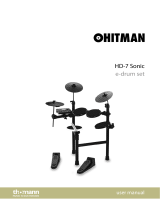
2
Contents
DRUM KIT .......................................... 4
: DRUM KIT Screen ................................ 4
: KIT SETTINGS .................................... 4
KIT SETTINGS 1 (page 1) ............................. 4
KIT SETTINGS 2 (page 2) ............................. 5
PAD CONTROL (page 3) .............................. 5
PAD MIDI (page 4).................................... 6
KIT CUSTOMIZE ................................... 8
: INSTRUMENT..................................... 8
INSTRUMENT (page 1) ............................... 8
TRANSIENT (page 2).................................. 11
SUB INST (page 3) .................................... 12
: AMBIENCE ........................................ 14
AMBIENCE (page 1) .................................. 14
OVERHEAD (page 2).................................. 14
ROOM (page 3)....................................... 18
: MIXER ............................................. 22
MIXER VOLUME (page 1) ............................. 22
PAD EQ (page 2)...................................... 23
PAD COMP (page 3) .................................. 23
MULTI EFFECT (MFX) (page 4) ......................... 24
MASTER COMP (page 5).............................. 25
MASTER EQ (page 6) ................................. 26
USER SAMPLE ..................................... 28
SAMPLE LIST ....................................... 28
SONG . . . . . . . . . . . . . . . . . . . . . . . . . . . . . . . . . . . . . . . . . . . . . . . . 29
: SONG.............................................. 29
SONG (page 1) ....................................... 29
SONG INFO (page 2) ................................. 29
SET LIST............................................. 30
: SETUP ............................................. 30
CLICK ................................................ 31
: Making the Click Play (Metronome) ............... 31
: Rhythm Training (Coach Mode) .................... 32
Correctly Playing in Time with the Beat (TIME CHECK) 32
Developing Internal Timing Sense (QUIET COUNT).... 33
WARM UPS . . . . . . . . . . . . . . . . . . . . . . . . . . . . . . . . . . . . . . . . . 34
TRIGGER ............................................ 36
: TRIGGER .......................................... 36
TRIG BASIC (page 1) .................................. 36
TRIG ADVANCED (page 2) ............................ 39
TRIG MONITOR (page 3).............................. 41
SETUP ............................................... 42
: OUTPUT........................................... 42
PAD OUTPUT (page 1)................................ 42
OTHER OUTPUT (page 2) ............................. 43
OUTPUT ROUTING (page 3) .......................... 43
: USB AUDIO ....................................... 45
Conguring the Routing for USB Audio
(Audio Routing) . . . . . . . . . . . . . . . . . . . . . . . . . . . . . . . . . . . . . . . . 46
: OPTION ........................................... 47
: CONTROL ......................................... 48
: MIDI ............................................... 49
: AUTO OFF......................................... 51
: INFO ............................................... 51
Multi-Eect Parameters......................... 52
DELAY .............................................. 53
TAPE ECHO ......................................... 53
REVERSE DELAY .................................... 53
3TAP PAN DELAY ................................... 54
OD
0
DELAY ....................................... 54
DS
0
DELAY ....................................... 54
CHORUS............................................ 54
SPACE-D............................................ 54
OD
0
CHORUS..................................... 55
DS
0
CHORUS ..................................... 55
PHASER A .......................................... 55
PHASER B .......................................... 55
STEP PHASER....................................... 55
FLANGER........................................... 56
REVERB............................................. 56
LONG REVERB ...................................... 56
SUPER FILTER....................................... 57
FILTER+DRIVE ...................................... 57
AUTO WAH ......................................... 57
OD/DS
0
TWAH ................................... 58
LOFI COMPRESS.................................... 58
DISTORTION........................................ 58
OVERDRIVE......................................... 58
SATURATOR ........................................ 58
T-SCREAM .......................................... 58
BIT CRUSHER ....................................... 59
ISOLATOR .......................................... 59
RING MODULATOR................................. 59
PITCH SHIFTER ..................................... 59
AUTO PAN.......................................... 60
TIME CTRL DLY ..................................... 60
PAN DELAY . . . . . . . . . . . . . . . . . . . . . . . . . . . . . . . . . . . . . . . . . 60
SDD-320 ........................................... 60
SBF-325 ............................................ 61
SPEAKER SIM ....................................... 61
GUITAR AMP SIM ................................... 62
LOW BOOST........................................ 63
ENHANCER......................................... 63





















